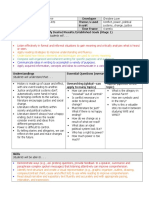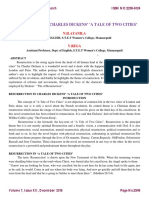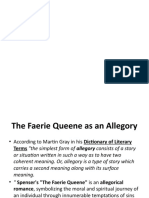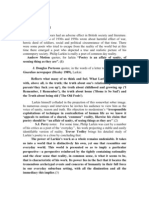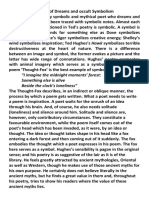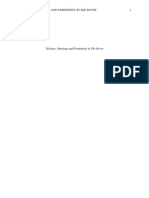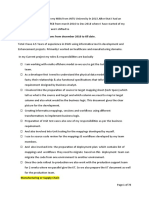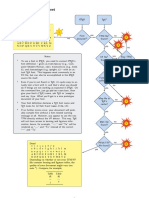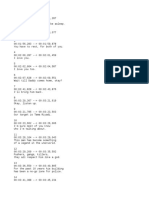Professional Documents
Culture Documents
Congreve's Use of Wit and Humour. SH C
Congreve's Use of Wit and Humour. SH C
Uploaded by
Shahnawaz HussainOriginal Description:
Original Title
Copyright
Available Formats
Share this document
Did you find this document useful?
Is this content inappropriate?
Report this DocumentCopyright:
Available Formats
Congreve's Use of Wit and Humour. SH C
Congreve's Use of Wit and Humour. SH C
Uploaded by
Shahnawaz HussainCopyright:
Available Formats
Congreve’s use of Wit and Humor in The Way of the World
In raising his own comedy of manners, Congreve has “imitated the earlier
mode of writings in The Way of the World”. We notice a great influence of earlier
drama on the play. The influence of Shakespeare is discernible; so is Ben Jonson’s. By
distinguishing the authentic variety of wit from the destructive, idle one Congreve
has not only enhanced the dramatic appeal of the play, he reminds us of
Shakespeare and comes out unscathed from the charge of immorality and obscenity.
He has written The Way of the World, in keeping with the conventions of the
Restoration comedy of manners with a perfect use of satire, irony, wit and humor.
In his essay, Concerning Humour in Comedy, Congreve shows a clear
understanding of the importance of the humours tradition in English comic writing
and offers a definition of what is meant by the term 'humour' that is obviously
inspired by both Ben Jonson and John Dryden:
“I take it to be, A singular and unavoidable manner of doing, or saying anything,
Peculiar and Natural to one Man only; by which his Speech and Actions are
distinguished from those of other Men.”
In the same essay, he takes great pains to distinguish humour both from wit
and from affectation. As he explains, wit is often mistaken for humour (as is its
opposite, folly). But wit is something quite different. It is a manner of response that
may be used by a character rather than a determining feature affecting the whole
behaviour of the character. As Congreve expresses it:
”Every person in a comedy may be allowed to speak them [pleasant things]. From a
witty man they are expected and even a fool may be permitted to stumble. . . . I do
not think that humorous characters exclude wit; no, but the manner of wit should be
adapted to the humour . . . ; a character of a splenetic and peevish humour should
have a satirical wit. A jolly and sanguine humour should have a facetious wit.”
He clearly distinguishes between true wit and false wit. In providing an
explanation of the term the era of Congreve‟s society has to be considered as well
because the meaning of the word shifted throughout the history. Gelber mentions
that while in the sixteenth century wit stood for genius or wisdom, in the seventeenth
century its meaning narrowed to a “capacity for ingenuity, an ability to make
unexpected unions or contrast of generally diverse ideas” (Gelber). For both Pope
and Addison “wit involved good taste, morality and it was essentially interchangeable
with the idea of literary genius.”
Wit is indeed closely connected to language, but is not expressed solely in
words and speeches. It is also reflected through action. The central characters of the
play Mirabell and Fainall are both very good rhetoricians; therefore it is the deeds
rather that discourse that distinguish the true wit that is Mirabell from Fainall, who
only feigns it, however masterfully at times, using the language of a gentleman to
mask his real spiteful and vicious nature. The way they both plot against Lady
Wishfort brilliantly highlights the differences that demark the two characters. Fainall
is unscrupulously pursuing his ambition to obtain his mother-in-law’s fortune and he
is willing to destroy his wife’s reputation, to let her turn “adrift like a leaky hulk to
sink or swim”, thus fully uncovering his absolute lack of morality and false wit. His
instincts are not accurate enough and he gets lost in his schemes. In his final scene,
when he is faced with the evidence of the parchment that allocates his wife’s estate
“in trust to Edward Mirabell” , he cannot control his rage or find words to fight or
defend himself, but flees after a failed attempt to assault his wife, which proves his
ultimate defeat on the rhetorical battlefield as well.
The world of Congreve‟s play is full of false wits, but there still can be
found true wit between Mirabell and his love interest Millamant show superiority of
wit among others. However, just as would-be wits have their moments of brightness,
those two also struggle, but even when they are “laughable at times, in the main they
are sympathetic and by the awareness of the way of the world (and a certain degree
of luck) they are able to escape its ever-present dangers” (Kaufman 412). They learnt
to conduct themselves in the society with sense of propriety and sufficient level of
self-discipline. Mirabell does not pursue his scheme unscrupulously as Fainall does,
but ensures that it does not pose real danger to Lady Wishfort, when he links her
with a suitor that is already married. He pleads that it was an innocent device even
though “it had a face of guiltiness” and that he has never intended to cause lasting
distress to Lady Wishfort. Indeed, through his action he distances himself from Fainall
and professes his moral superiority.
Congreve’s creative art of characterization for satirizing the people of his age can
be seen even through the portrayal of his humourous pair, Witwoud and Petulant that works
out the two kinds of inept imposture and nonsense ‘which are powerful in their ability to
annoy the rest of the community without even realizing it’. We also have Sir Wilfull, who is
rustic and being a misfit in hierarchy society is not a simple object for satiric comedy. Sir
Wilfull is mildly satirized, but his honest and unassuming character is a sitting contrast with
the affectations of the artifices of the town. Through him Congreve criticizes the mannered
world of sundry fashions.
In conclusion, Congreve‟s play The Way of the World offers a complex
representation of wit and humor in great forms. He uses typical wit-woulds from the
Restoration comedies, but he operates with them in such a way that they do not
remain only rigid and laughable characters. The barrier between them and true wits
is sometimes so thin that they are almost indistinguishable from each other.
However, in comparison to Mirabell or Millamant their affected wit (as Congreve
called it in his dedication) proves to be false. The discourse of such characters does
not possess sufficient subtlety or propriety and their actions lack sense of morality.
As a result their schemes eventually succumb to those flaws, leaving them defeated
in the game of society.
BIBLIOGRAPHY:-
1. Congreve’s The Way of the world, Sengupta Kajal.
2. ‘William Congreve’, David Thomas, Macmillan.
3. Congreve’s “Concerning Humour in Comedy”.
4. Anthony Kaufman’s “Language and character in Congreve’s the way of the
world.”
You might also like
- UbD Animal FarmDocument3 pagesUbD Animal FarmAlisha Nangia100% (1)
- Epistolary in Pamela@ SHDocument3 pagesEpistolary in Pamela@ SHShahnawaz HussainNo ratings yet
- Gullivers As An AllegoryDocument4 pagesGullivers As An AllegoryFaisal JahangeerNo ratings yet
- Ode To A Nightingale: Transience Vs PermamnenceDocument1 pageOde To A Nightingale: Transience Vs PermamnenceArijit DasNo ratings yet
- Comedy of HumoursDocument29 pagesComedy of HumoursAmalia Mihaela GrososNo ratings yet
- A Note On The Philosophy of Life in Hardy's The Mayor of Casterbridge.Document2 pagesA Note On The Philosophy of Life in Hardy's The Mayor of Casterbridge.sahityasikshayatanNo ratings yet
- COLERIDGEDocument3 pagesCOLERIDGEAravind G Krishnan100% (1)
- Summary of To AutumnDocument2 pagesSummary of To AutumnSr Chandrodaya JNo ratings yet
- Francis Bacon - of Travel PDFDocument2 pagesFrancis Bacon - of Travel PDFSomapti Das100% (1)
- In MemoriamDocument2 pagesIn MemoriamRaluca Pascu100% (1)
- Theme of ResurrectionDocument3 pagesTheme of ResurrectionFaisal JahangeerNo ratings yet
- Joseph AndrewsDocument3 pagesJoseph AndrewsKaushik RayNo ratings yet
- Next, Please by Philip LarkinDocument4 pagesNext, Please by Philip LarkinLijimol GeorgeNo ratings yet
- Epic Similes in Paradise Lost - Book IDocument2 pagesEpic Similes in Paradise Lost - Book Iajay devganNo ratings yet
- Religious and Moral or Spiritual AllegoryDocument11 pagesReligious and Moral or Spiritual Allegoryfaisal jahangeerNo ratings yet
- 100%conflict Between Science and Religion of Victorian PeriodDocument2 pages100%conflict Between Science and Religion of Victorian PeriodMd Masud Rana100% (1)
- Dream Children by Charles LambDocument3 pagesDream Children by Charles LambAbhey JindalNo ratings yet
- English Poetry Between The Two WarsDocument5 pagesEnglish Poetry Between The Two WarsTANBIR RAHAMANNo ratings yet
- Money and Marriage in Pride and PrejudicDocument2 pagesMoney and Marriage in Pride and Prejudicajay devgan100% (1)
- Lawrence Sterne Anti - NovelDocument4 pagesLawrence Sterne Anti - Novelالمطبخ الراقيNo ratings yet
- Ulysess Dramatic MonologueDocument1 pageUlysess Dramatic Monologueavishek saha100% (1)
- Who Is Mrs MalapropDocument5 pagesWho Is Mrs Malapropnjvcgfcbn100% (1)
- Bonsai and Dwarfish Maturity in Bravely Fought The QueenDocument2 pagesBonsai and Dwarfish Maturity in Bravely Fought The QueenSomenath DeyNo ratings yet
- Robinson Crusoe As A Novel of British ColonialismDocument7 pagesRobinson Crusoe As A Novel of British ColonialismPetra MusulinNo ratings yet
- London by Samuel Johnson Satirical Mode PDFDocument4 pagesLondon by Samuel Johnson Satirical Mode PDFSharmila DasNo ratings yet
- The Way of The World: Proviso SceneDocument2 pagesThe Way of The World: Proviso SceneweepingmeadowNo ratings yet
- Tennyson As A Representative of The Victorian PeriodDocument3 pagesTennyson As A Representative of The Victorian PeriodBaloch Karawan50% (2)
- The Mill On The FossDocument5 pagesThe Mill On The FossDanyal Khan100% (1)
- Character Analysis of Sir Roger de Coverley in Addison's EssayDocument7 pagesCharacter Analysis of Sir Roger de Coverley in Addison's EssayRohit DahiyaNo ratings yet
- Tess of The D'Urbervilles: Tess - A Pure WomanDocument2 pagesTess of The D'Urbervilles: Tess - A Pure WomanCh M Naeem UllahNo ratings yet
- Supernatural Elements in The TempestDocument1 pageSupernatural Elements in The TempestAatman Gupta100% (1)
- Philip Larkin Is One of BritainDocument7 pagesPhilip Larkin Is One of Britainchandravinita100% (1)
- Pomegranates Series, Were For The Most Part Unsuccessful. Nevertheless, The Techniques He Developed Through His Dramatic MonologuesDocument36 pagesPomegranates Series, Were For The Most Part Unsuccessful. Nevertheless, The Techniques He Developed Through His Dramatic MonologuesManu JamesNo ratings yet
- Charles Lamb: Irony and Wit Is The Common Subject of His Essays. Nineteenth CenturyDocument2 pagesCharles Lamb: Irony and Wit Is The Common Subject of His Essays. Nineteenth Centuryarbaz100% (1)
- Discuss Hughes' Use of Dreams and Occult SymbolismDocument16 pagesDiscuss Hughes' Use of Dreams and Occult SymbolismJimmi KhanNo ratings yet
- ILLL Samuel Johnson Priyadarshini 13 Oct PDFDocument19 pagesILLL Samuel Johnson Priyadarshini 13 Oct PDFBanasre Biswas100% (1)
- Wordsworth Sand Coldridge's Attitude Toward Nature.Document4 pagesWordsworth Sand Coldridge's Attitude Toward Nature.ফাতিমা তমাNo ratings yet
- The MadnessDocument9 pagesThe MadnessNiall FarleyNo ratings yet
- Use of Art and Painting in Andrea and LippoDocument6 pagesUse of Art and Painting in Andrea and LippoBipasha SenNo ratings yet
- Compare/Contrast Dr. Frankenstein and "The Monster"Document3 pagesCompare/Contrast Dr. Frankenstein and "The Monster"Faruk R AhamedNo ratings yet
- 1260416426critical Appreciation of To A SkylarkDocument2 pages1260416426critical Appreciation of To A SkylarkSourav Kumar100% (2)
- Trickery, Marriage and Femininity in The Rover 1Document8 pagesTrickery, Marriage and Femininity in The Rover 1Akshay Bhardwaj100% (1)
- Symbols in The Poem The Second ComingDocument2 pagesSymbols in The Poem The Second ComingSr Chandrodaya J100% (1)
- Arms and The Man As Anti War PlayDocument2 pagesArms and The Man As Anti War PlayFarha NeelNo ratings yet
- Damnation FaustusDocument2 pagesDamnation FaustusAly FahadNo ratings yet
- 10C - Not My Best SideDocument1 page10C - Not My Best SideWilliam BurnNo ratings yet
- Emma ThemesDocument4 pagesEmma ThemesKiran RiazNo ratings yet
- Kubla Khan As A FragmentDocument1 pageKubla Khan As A FragmentAnindita Bhowmik0% (1)
- A Critical Comment On Samuel Johnsons Lo PDFDocument4 pagesA Critical Comment On Samuel Johnsons Lo PDFBanasre BiswasNo ratings yet
- University WitsDocument5 pagesUniversity WitsSiya SunilNo ratings yet
- Gulliver's Travels As Travel Literature.Document3 pagesGulliver's Travels As Travel Literature.Saad Saeed100% (1)
- Sons and Lovers Title SignificanceDocument1 pageSons and Lovers Title SignificanceMiles Edgeworth100% (1)
- "Twicknam Garden The PoemDocument11 pages"Twicknam Garden The Poemmarishkagupta67% (3)
- Woman To Man Judith Wright Umesh Sir AssignmentDocument3 pagesWoman To Man Judith Wright Umesh Sir AssignmentArnab MukherjeeNo ratings yet
- Supernatural Elements inDocument4 pagesSupernatural Elements inTANBIR RAHAMANNo ratings yet
- The Republic Book 10Document10 pagesThe Republic Book 10Shivam Kaundinya100% (1)
- Critical GulliversDocument3 pagesCritical Gulliversfarah zaheer100% (1)
- Auden As A Poet of NatureDocument4 pagesAuden As A Poet of Naturemanazar hussain100% (1)
- Wonder of Renassance and Return To NatureDocument9 pagesWonder of Renassance and Return To NatureShan SumalaniNo ratings yet
- Dream Children-Charles Lamb and Psychoanalytic PerspectiveDocument7 pagesDream Children-Charles Lamb and Psychoanalytic PerspectiveAisha Rahat100% (1)
- Don Juan As A Byronic Hero. SH DDocument3 pagesDon Juan As A Byronic Hero. SH DShahnawaz HussainNo ratings yet
- @ Supernatural in The Rime of The Ancient MarinerDocument3 pages@ Supernatural in The Rime of The Ancient MarinerShahnawaz HussainNo ratings yet
- The Flight of Imagination in Keats' Ode To A Nightingale'. SHDocument2 pagesThe Flight of Imagination in Keats' Ode To A Nightingale'. SHShahnawaz HussainNo ratings yet
- Vedic Studies Voli 033245 MBPDocument308 pagesVedic Studies Voli 033245 MBPRa El100% (1)
- Rubric For Speaking Test-Level: B1: Needs Improvement 1 Pts Satisfactory 2 Pts Good 3 Pts Excellent 4 PtsDocument1 pageRubric For Speaking Test-Level: B1: Needs Improvement 1 Pts Satisfactory 2 Pts Good 3 Pts Excellent 4 PtsVũ Nhất AnNo ratings yet
- Practice On TensesDocument2 pagesPractice On TensesLinh ĐanNo ratings yet
- THE USE OF SHADOWING TO TEACH ENGLISH PRONUNCIATION INMaxim BarkovDocument10 pagesTHE USE OF SHADOWING TO TEACH ENGLISH PRONUNCIATION INMaxim BarkovLorena CostillaNo ratings yet
- A Lesson Plan in English 9 Ininitive VerbsDocument2 pagesA Lesson Plan in English 9 Ininitive VerbsRajah, Jihan M. M. RajahNo ratings yet
- APRENDISIMO Irregular VerbsDocument1 pageAPRENDISIMO Irregular VerbsAlexNo ratings yet
- Olimpiada de Limba EnglezăDocument3 pagesOlimpiada de Limba EnglezăRomelia ZalanaNo ratings yet
- Lecture 03 SynthesizableHDL PDFDocument105 pagesLecture 03 SynthesizableHDL PDFSiva PrasadNo ratings yet
- Ms DosDocument3 pagesMs Dosnani9949No ratings yet
- I. Read The Text and Answer The Questions Choosing The Right AnswerDocument11 pagesI. Read The Text and Answer The Questions Choosing The Right AnswerInna YengibaryanNo ratings yet
- Informatica Interview Questions and AnswersDocument78 pagesInformatica Interview Questions and AnswersPAVANN TNo ratings yet
- Balkans - Definition, Map, Countries, & Facts - BritannicaDocument7 pagesBalkans - Definition, Map, Countries, & Facts - BritannicaxyaciocsNo ratings yet
- ERPW Unit4 Studymaterial JrsDocument33 pagesERPW Unit4 Studymaterial JrsBandi vennelaNo ratings yet
- Tex Font CheatsheetDocument3 pagesTex Font CheatsheetSándor Nagy100% (1)
- Document 2Document22 pagesDocument 2diekbluesNo ratings yet
- Taklimat Ujian Lisan PT3Document33 pagesTaklimat Ujian Lisan PT3Khirol Azuddin100% (1)
- Research For 21st Century LitDocument9 pagesResearch For 21st Century LitClaire ArribeNo ratings yet
- How To Connect A Windows 7 Computer To The Internet Via An Android PhoneDocument1 pageHow To Connect A Windows 7 Computer To The Internet Via An Android PhoneMuhammad NaseemNo ratings yet
- The Cambridge CriticsDocument5 pagesThe Cambridge CriticsanaaremereNo ratings yet
- Out of The Cloister. Scholastic Exegesis of The Song of Songs, 1100-1250 - Suzanne LaVere (Brill, Leiden 2016)Document202 pagesOut of The Cloister. Scholastic Exegesis of The Song of Songs, 1100-1250 - Suzanne LaVere (Brill, Leiden 2016)Medieval AsesoríasNo ratings yet
- ETRUSCANDocument16 pagesETRUSCANCatherine Hughes100% (1)
- Chapter 3 Lesson 2 - Implementing A Curriculum Daily in The ClassroomDocument17 pagesChapter 3 Lesson 2 - Implementing A Curriculum Daily in The ClassroomAriell Emradura80% (5)
- MTB Mle Lesson Plan DemonstrationDocument4 pagesMTB Mle Lesson Plan DemonstrationAngie BaranganNo ratings yet
- KeywordsDocument66 pagesKeywordsMejri Mouhamed AliNo ratings yet
- Ramya Rao 0515 (1) - 2-1-1Document2 pagesRamya Rao 0515 (1) - 2-1-1ADITYA REDDY MEKALANo ratings yet
- Farrell J Java Programming 6th Ed 2011 PDFDocument2 pagesFarrell J Java Programming 6th Ed 2011 PDFToddNo ratings yet
- The Raid Redemption 2011 (Serbuan Maut) HDRip XviD AVI Eng Language - CBCSDocument39 pagesThe Raid Redemption 2011 (Serbuan Maut) HDRip XviD AVI Eng Language - CBCSJaybertFiaraochanNo ratings yet
- Another Method of Bypassing ETW and Process Injection Via ETW Registration EntriesDocument18 pagesAnother Method of Bypassing ETW and Process Injection Via ETW Registration EntriesJacobus BooysenNo ratings yet
- Pope Francis Apologizes To Indigenous Peoples For Grave Sins of ColonialismDocument2 pagesPope Francis Apologizes To Indigenous Peoples For Grave Sins of Colonialismsherman lyonsNo ratings yet
